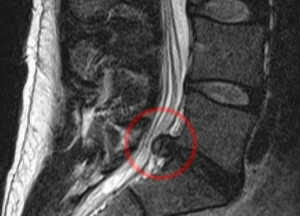 The human spine is designed in such a way that it is capable of withstanding rather large loads.
The human spine is designed in such a way that it is capable of withstanding rather large loads.
It is flexible enough and at the same time has high strength, because one of its functions is the protection of the spinal cord that passes through the spinal canal.
But the limit is for everything, including the spine. Due to heavy loads, unsuccessful falls or simply with age, such a problem as a hernia of the intervertebral disc may arise.
The disc itself consists of an outer shell and an internal substance, when, at certain factors, the contents of the disc fall out, it can crush either the nerve roots along the spine or the spinal cord itself. In this case, a person experiences severe pain, it is also possible to lose sensitivity in some parts of the body and even disability.
Surgical solution of the problem is a discectomy - operative removal of the intervertebral disc in whole or in part. When removing the disc( or part of it), the pressure on the nerve endings is eliminated. In some cases, the dialysis is complemented by a laminectomy, when a part of the vertebra is also removed.
For the first time such an operation was carried out in 1922 by Adson, when he successfully removed the dropped disk in the cervical section. To this day, this method of intervention is the most acceptable way to treat the fallen disc.
Contents of the article
- Contents of the article
- Indications for operation
- Contraindications
- Preparatory stage
- Three methods - three different approaches
- What mechanisms and devices are used
- Advantages and disadvantages
- Rehabilitation period
- They went through this
- Possible expenses
Indications for operation
In most cases,to conservative treatment, which includes:
- taking anti-inflammatory medications;
- epidural injections into the area of inflamed nerve endings;
- rest;
- physiotherapy procedures;
- special physical exercises aimed at reducing the pressure of the disc on the nerve roots.
In some cases, the disc dropped after such treatment shifts or assumes a position that no longer interacts with nerve endings. Then the hernia symptoms go away and the patient is relieved.
Operative treatment is required if the following symptoms are noted:
- pain and numbness in any parts of the body do not last a long time;

- in the muscles feels an unusual weakness;
- has problems with urination and defecation;
- pain is strong enough, prolonged and it can not be stopped by strong drugs;
- on the hernia occurs calcium deposition;
- increases the size of education.
Contraindications
Despite the comparative simplicity of this surgery and it has limitations:
- pregnancy;
- poor blood clotting;
- diabetes mellitus;
- heart failure;
- presence of an infectious disease;
- is an inflammatory process in the body;
- respiratory system problems;
- positive results with conservative treatment.
Preparatory stage
 Before the operation, a careful medical history should be collected. It is supposed to examine the patient, find out the nature of the pain, their duration, localization.
Before the operation, a careful medical history should be collected. It is supposed to examine the patient, find out the nature of the pain, their duration, localization.
In addition, it is necessary to perform MRI diagnostics to obtain accurate images of the spine. Recently, the discography procedure has been increasingly used. It involves the introduction of an intervertebral disc of contrast medium and the subsequent x-ray.
Before the operation, a standard set of tests is submitted and several diagnostic procedures are performed:
- biochemical blood test;
- radiography;
- electrocardiography;
- coagulogram.
It is mandatory to consult an anesthesiologist.
12 hours before surgery, it is advisable not to eat, and taking certain medications will need to be canceled at least three days before the intervention.
Three methods - three different approaches
The procedure itself can be performed in 3 versions:
- Classics .The operation is performed under general anesthesia. Classical discectomy is performed in the lumbar region and is performed via the rear access. In the desired area, a skin incision is made( up to 10 cm), the surgeon spreads the muscles with special tools, then removes the damaged disc, if necessary cauterizes the nerve roots, and finally laminates the wound layer by layer. All this lasts about 2 hours.
- Microdiscectomy .With this method, a very small incision of about 3 cm is made. The procedure itself is performed using an operating microscope. First, the doctor dilutes the muscles, and then takes away the nerve roots, then removes the tissue of the intervertebral disc.
- Endoscopic Discectomy .The least traumatic method of hernia removal. A minimum incision of 1.5-2 cm is made on the skin, after which the doctor, controlling the endoscope and monitoring through a special monitor, removes the disc. The operation is performed using epidural or local anesthesia.

The adjacent vertebrae after the operation are fused. Sometimes bone transplantation may be required to maintain the spine. After the operation, a drainage tube is inserted into the wound, which after a few days is removed.
How is lumbar discectomy done:
What mechanisms and devices are used for
Microdiscectomy uses a medical microscope and microsurgical instruments. The size of the working part of microsurgical instruments does not exceed 2-4 mm.
Endoscopic technique uses an endoscope with a diameter of up to 7 mm. The endoscope is a tube that is inserted into the human body and consists of a lighting element and a camera that transmits the image to the screen or to the eye of the microscope. The surgeon performs the operation by inserting into the canal of the endoscope surgical instruments.
Directly removing the disc can occur with conventional surgical instruments and with a special laser.
Advantages and disadvantages of
The disadvantages are the possibility of developing the following complications: 
- repeated falling out of the inner part of the disk with incomplete removal;
- inflammation of the spinal cord;
- impaired sensitivity of the skin or certain parts of the body due to damage to the nerve endings;
- occurrence of thrombosis in the veins of the lower limbs;
- bladder or bowel incontinence.
In rare cases, if nerve endings or spinal cord have been damaged, paralysis is possible, however, it is worth remembering that the percentage of such outcomes is minimal.
The pluses include a relatively fast and long-term effect. After the removal of the hernia, after a while a person can lead the old way of life. Retreat strong pain, numbness, normalizes the general condition and pass neurological symptoms.
Rehabilitation period
After the operation, the patient needs to lie on his back for at least 24 hours, he can only sit for a month. Sutures are removed on day 14.
After a while, moderate physical activity is possible, however, you can not lift objects weighing more than 3-4 kg. Within 2 months, a special medical corset is shown that helps support the spine.
For the first time prescribed special painkillers. Over time, it is necessary to connect exercise therapy.
They went through this
. As things stand in practice, you can learn by studying the testimonials of people who have had a discectomy.
I had an operation in 25 years. The disk was removed between 4 and 5 vertebrae in the lower back. In my case, conservative treatment would not help, because there was a paralysis. I was operated under general anesthesia, now it's been six months, and there was a small scar. Most of all inconveniences were delivered by the postoperative period, it was necessary to wear a corset, to remember constantly that you can not lift something heavy and keep your back straight. I am pleased with the result, because side effects have not touched me, and I can continue to live the same life.
Karina, 35
I had surgery almost a year ago, I removed a hernia between the vertebrae of L4-L5.Before the operation I experienced terrible pains, one leg sometimes was taken away, limped. After the operation, almost everything was normal, but there was numbness on one toe. Now I swim a lot and walk about 8 km per day on a home treadmill. His condition is satisfied, the main thing is not to stop moderate physical activity in order to maintain the result.
Sergey, 41
Possible expenses
Treatment can be carried out free of charge, thanks to the MHI policy in the neurosurgical department of any hospital.
However, it is possible to undergo treatment in a private clinic, having previously chosen a doctor with whom you can agree the method of operation. The cost of removing one hernia varies from 40 to 120 thousand rubles, depending on the chosen method.



